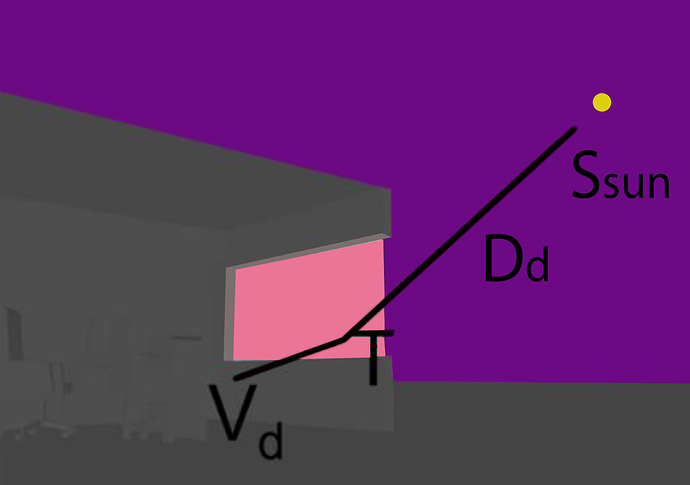Hello,
I am going to simulate a prismatic glazing in Radiance. Instead of regular sky matrix, I want to do the simulation by Sun matrix, like the picture below, but do not know how to do that.
I think we need more detail. How are you modeling the prismatic glazing? Do you want point sources arranged a la Reinhart positions in the sky? How do you plan to apply the matrix? Maybe offer some context for your problem.
I have BSDF file (tensor tree xml file) of the prismatic panel.
The sky I need to simulate with is Reinhart subdivision scheme (MF:6).
My goal is to simulate the prismatic glazing so that all the incident sunlight come from a specific point (not a patch).
I am new in Radiance but what I am thinking is:
The last phase of 5-phase method (CdsSsun) would do that but I am not sure if it takes the BSDF file into consideration or not.
Probably, the best way would be a three-phase method simulation with Reinhart sky subdivision scheme (MF:6).
I don’t have it in front of me, but I believe you should be able to follow the method in the 5-phase method as you say. Basically, you need to create a sky full of suns at the Reinhart locations – I think Andy McNeil wrote a script called “gensuns” for this, but I don’t know that it ever found its way into the standard distribution. The manual commands are:
cnt 5185 | rcalc -e MF:6 -f rskysrc.cal -o sun.fmt > mysuns.rad
sed -n 's/^.* \(slight[1-9][0-9]*\)$/\1/p' mysuns.rad > sunmod.txt
where the file “sun.fmt” contains:
void light slight${recno}
0
0
3 1e5 1e5 1e5
slight${recno} source sun${recno}
0
0
4 ${ Dx } ${ Dy } ${ Dz} 0.5
You can then run rcontrib or rfluxmtx using the mysuns.rad file as your receivers and -M sunmod.txt as your modifier list. Does this make sense?
Hi Mohammad,
in general I’d recommend to get an image out of rpict or trace first for one time-step (“one sun”), before proceeding further along the CBDM path. Once you are sure that your model is valid, Sarith’s “Daylighting simulations with Radiance using matrix-based methods” is the reference: https://www.radiance-online.org/learning/tutorials/matrix-based-methods
Best, Lars.
